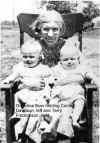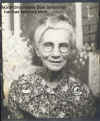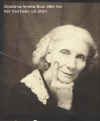



Amelia Olson, our Norwegian grandmother, was born on February 22, 1873, in the dugout home of her parents, Hans and Ellen Olson. There is much more on her parents, and particularly her mother, than will appear here in the article entitled: "What Price, Buffalo Valley?" included in the Archives section. They were both emigrants from Norway. Hans was born in 1830 near Oslo, trained as a shoe cobbler, and came to this country in 1867 or 1868. He apparently came first to Chicago and then for reasons unknown decided to come to Kansas and homestead some of the land available.
It was an undertaking of extraordinary daring, one of utter foolhardiness, or some combination of the two. He was alone, he was not a farmer and had no tools or equipment to go with his lack of experience, and, while Kansas had been a state for all of eight years when he arrived, it was hardly pacified, let alone civilized. Ben White, a homesteader in an adjoining township, was killed by a band of Cheyenne and his daughter abducted and carried away in 1868. The frontier was very much still in the process of being opened when Hans filed his claim and dug the hole in the ground that, when covered over with brush and sod, would be home to him and his family for several years.
Hans had, according to Ms. Gail French Petersonís account, left his sweetheart behind in Norway and wrote and persuaded her to come to Kansas and marry him. The term "mail-order bride" has been used to describe her in some of the family oral history. Ms. Petersonís account would belie that terminology, but Hans and Ellen, who may have been the only ones who ever knew the truth of the matter, died in 1884 and 1917, respectively.
 Mother did remember her grandmother with great fondness. She
recalled having stayed with her on several occasions and had quite vivid
memories of her. Her grandfather was, of course, long gone before she was born.
She described her grandmother as
being a small woman of great energy and vitality. This picture would certainly
be consistent with the account given by Ms. Peterson and the impression one
obtains from the one picture we have available. This picture includes all of her
daughters and several of Motherís elder siblings and is also included in the
Photograph Album.
Mother did remember her grandmother with great fondness. She
recalled having stayed with her on several occasions and had quite vivid
memories of her. Her grandfather was, of course, long gone before she was born.
She described her grandmother as
being a small woman of great energy and vitality. This picture would certainly
be consistent with the account given by Ms. Peterson and the impression one
obtains from the one picture we have available. This picture includes all of her
daughters and several of Motherís elder siblings and is also included in the
Photograph Album.
Amelia Olson was the eldest of six children born to Hans and Ellen. One died in infancy, but the remaining five lived to ripe ages. Two of the five, Peter and Matilda, remained unmarried. Amelia, Regina (Gina, hard G), and Louisse all married and had families. Amelia was without doubt born in that dugout home, but it is not clear that she was the baby that had just been born in Ms. Frenchís account involving the snake because some of the younger siblings were born there as well. None of us alive today can have any real comprehension of the danger and difficulty involved in carving out an existence in those circumstances.
We do not have the benefit of very much information about Ameliaís early life. It is beyond assumption that she was reared in a very devout Lutheran environment. Her parents were charter members of the St. Lukeís Lutheran Church which is located about five miles from their homestead. According to Motherís account, her grandfather, having no horse, walked from homestead to homestead to help gather members and funds to start the church. Mother said she was confirmed in St. Lukeís Church and remembered with great pleasure having worshiped there many times.
There is no hard information about Ameliaís education, but there is no doubt that she did attend school. She was a literate person who enjoyed reading. The History of Cloud County indicates that rural school districts were being formed in the area about the time of her birth in 1873.
The organizational meeting of District 32, which was later to become the Jamestown School District, was held in 1872. It was decided to have a school term of three months that would require a tax rate of 7.5 mills. The first term was taught in a dugout located just west of the present site of Jamestown. At the outset, the district included an area north of Buffalo Creek where the Olson homestead was located.
In 1875, however, a controversy developed with some families desiring to have the school location moved further to the east in the district. This desire was not accommodated, and a new district, District #65 was formed north of Buffalo Creek. This new school, known as Rocky Hollow, was located in Section 11 of Grant Township immediately to the north and east of the Olson homestead. The first term of instruction was in 1882-83, with a total of 32 students and an average attendance of 18 reported. The Olson children attended this school.
Amelia Olson married Edmund Buer on January 29, 1893, just short of her twenty-first birthday. Edmund was 31 years old at the time. We do not know how they first met.
The 1895 Kansas Census indicates that Amelia, Edmund, and their first child, Anna, were living with her parents. A second daughter, Ella was born in 1896, and a third, Julia, in 1899.The family was completed with Motherís birth in 1911 and that of Margaret in 1913. Nine children had been born over a period of nineteen years. It is quite simply impossible for us living in an era of small families with modern conveniences, technology, transportation, and medical science and facilities to have any understanding of the challenge of bringing a brood of nine children to maturity.
There was no telephone, electricity, running water or
sanitation, natural gas, refrigeration, air conditioning, or money to purchase
clothing beyond shoes. The water was pumped by hand. The wood needed to cook and
heat the house was all cut the same way. Finally, for those of us who may have
felt or may now believe that raising two or three is a project of interminable
dimension, a brief reminder: Grandma Buer had children in diapers for an
uninterrupted period of 21 or 22 years. And, there were no Pampers.
She was a very small woman, less than five feet and never weighing as much as a hundred pounds. The sheer physical demands of what she did are astounding without giving any consideration to her diminutive size. They are almost miraculous when one does. There is little doubt, however, that she compensated with sheer determination what she lacked in size and strength.
Mother said that she could not remember of her parents arguing, let alone fighting. The children knew, however, when there had been a disagreement because, "it became very quiet". Mother described her father as being a fully qualified Norwegian when it came to obstinance, but hopelessly outclassed by her mother. She simply discontinued talking until he came to his senses, however long that might take.
 She was serious, quiet, and private, all in the extreme. I
teased Mother at times, referring to her, as I did at her funeral, as being the
"ultimate Norwegian". She was very Norwegian, but comparison with her
own mother would make her seem jolly, talkative and outgoing, a virtual
extrovert. In addition, I came to believe that, while Mother certainly loved and
respected her mother, she did not know her very intimately. When she did speak
of her mother, it was never in illuminating terms nor did it involve insights or
anecdotes that would have sharply defined her personality.
She was serious, quiet, and private, all in the extreme. I
teased Mother at times, referring to her, as I did at her funeral, as being the
"ultimate Norwegian". She was very Norwegian, but comparison with her
own mother would make her seem jolly, talkative and outgoing, a virtual
extrovert. In addition, I came to believe that, while Mother certainly loved and
respected her mother, she did not know her very intimately. When she did speak
of her mother, it was never in illuminating terms nor did it involve insights or
anecdotes that would have sharply defined her personality.
Grandma Buer did not have a very high opinion of Swedes as a group. It is not clear whether this was simply a Norwegian obligation, family training, or the result of direct experience. Mother told of Margaret coming home from school quoting from a poem written about the Battle of Copenhagen during a period of particular unpleasantness with the Swedes in 1658-59. I cannot remember the name of the poem or its author, but the line Aunt Margaret particularly relished was, "Ten thousand Swedes marched through the weeds at the Battle of Copenhagen". Her mother responded, apparently in a rather acidic tone, "Yes, and the women and children rolled rocks down on their heads".
Jan and I were never aware until years after Grandma was gone that she had not been particularly fond of her Swedish son-in-law either. Mother made statements to that effect on more than one occasion but would never elaborate. Extracting information she did not wish to disclose was not an option, and the reasons for her dislike, whatever they may have been, are simply unknown.
We did not know our Grandmother very well it would be fair to say. She lived most or all of her widowed years (1935-52) with her son, Harry, and his family or with Motherís sister Gladys and her family. We visited both places regularly, and Grandma would come and stay a week or two during the summer when we were small. She was not, however, an outgoing person by nature and not very communicative with us. It may have been that she was in the home of a Swede, or it may have been that she had had all of children that she could enjoy. The latter, at least, would be perfectly understandable.
The last time she came to stay, as I recall, was following a miscarriage Mother suffered in 1950 or 1951. Mother was in the Belleville Hospital and Grandma came to cook and look after us. We, of course, were then about ten and twelve and required no looking after from her or anyone else. We returned home from school on the horse the first evening of her tenure and proceeded in our accustomed pattern: change into chore clothes, prepare and drink one pint of chocolate malted milk, and start feeding cattle and preparing to milk the cows.
The chocolate malted milk (three heaping teaspoons Carnation chocolate malt in each pint, one pint for each boy) was easily the most inviolate element of the entire routine. Mother was not an imaginative cook and the challenge of packing school lunches every day was her least favorite task. The resulting lunches reflected her lack of enthusiasm. We typically ate as little of the lunch as we could get by on and threw the remainder away as we rode home, counting heavily on the chocolate malted milk to see us through two or two and half hours of chores to supper.
Grandma had obviously not been briefed on the malted milk convention. When we advanced on the refrigerator, she saw boys about to ruin the suppers she was there to fix for their welfare. She issued an immediate injunction protecting the entire contents of the refrigerator. Enforcement took the form of standing in front of the refrigerator door until we left.
Needless to say, we were outraged. The terms of our unwritten contract with management had been breeched. We were not only required to work like dogs, we were placed in jeopardy of starvation, as well. By the time Dad arrived home from the hospital, he had a full-fledged labor-management crisis on his hands. We were well rehearsed by that time and informed him that he had to get this straightened out or he would have to do the chores by himself.
We knew well that it was exactly this sort of impudence that would normally light Dadís shortest fuse, but we were angry enough not to care. For some reason, however, he did not get angry. He told us to finish feeding and start milking and that he would be there to help in a little while. Then, with the look of a man being led to the gallows, he went back to the house. No explanation was ever provided and we had the uncharacteristically good judgment not to ask for any, but he took Grandma back home after supper that evening.
We would not for years have the remotest understanding of the delicacy of the situation we had forced on him or of how difficult it must have been for him in those circumstances. We were equally oblivious to our grandmotherís perspective, as well. From the vantage point of many years, I now rather confidently imagine that she felt that her daughter had gotten just what she deserved for marrying that Swede.
Mother commented often on the fact that her mother was extremely
religious. I recall that she always brought her Bible when she came to stay and
read from it for extensive periods.
came to stay and
read from it for extensive periods.
She had been very fond of gardening and had extensive plantings of both flowers and vegetables. Mother reported that she took great pleasure from the fact that her flowers succeeded in attracting humming birds.
She was in declining health for several years before her death. She suffered form heart disease and ultimate succumbed to congestive heart failure at the age of 78.
History Charles Christine Carl & Alma Edmund Archives Genealogy